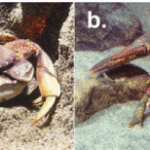Renghao Liang, A General Arthropod Joint Model and its Applications in Modeling Human Robotic Joints
Bearings are common rotational units, but these monocentric units do not realize high bio-imitability in exoskeleton robots. A common way to realize bionic motion is with an n-bar linkage mechanism within bearings, but the resultant joints can become complex. Herein, we propose a joint model based on the anatomy of grasshopper joints that consists of a pair of conjugate surfaces and a flexible connection body. An anatomical experiment involving crabs and lobsters reveals that the proposed joint model exists among crustaceans, which makes it a general joint structure for arthropods. After measuring the kinematic properties of crab and lobster joints, we have modified the joint model for robotics applications. An optimization algorithm is proposed for the design of the joint. A prototype of a bionic joint is fabricated and its kinematic characteristics are verified. The arthropod joint model is a promising mechanical unit in bionic robots.
Learn about our two Decals!
 Click here to find out more about our Fall Bioinspired Design Decal and our Spring Bioinspired Design in Action Decal – ALL MAJORS are welcome.
Click here to find out more about our Fall Bioinspired Design Decal and our Spring Bioinspired Design in Action Decal – ALL MAJORS are welcome.Berkeley BioDesign Community
 Click here to learn about the BioD: Bio-Inspired Design @ Berkeley student organization or here to signup for more info.
Click here to learn about the BioD: Bio-Inspired Design @ Berkeley student organization or here to signup for more info.Search
Student Login




I imagine that the neurological circuits underlying these processes are governed by both 2d spacing maps with their brains as…
to reduce the impact of car accidents, it may be possible to study the force diverting physics of cockroaches to…
you see this type of head-bobbing stability in many avian creatures related to pigeons like chickens. the head ability to…
not like they taught horses how to run! this is an example of convergent evolution where both sea creatures and…
The brain functions in a similar way with neuronal connections. our brains are able to utilize the multiplicity of connections…